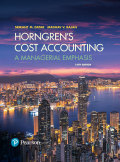
EBK HORNGREN'S COST ACCOUNTING
16th Edition
ISBN: 9780134475950
Author: Datar
Publisher: PEARSON CO
expand_more
expand_more
format_list_bulleted
Question
Chapter 11, Problem 11.18MCQ
To determine
Opportunity Cost:
Opportunity cost is total of potential income and other benefits that are lost due to rejection of alternatives. These costs are considered to evaluate the multiple project or options available.
Contribution Margin:
Contribution margin is the excess of selling price over the variable costs of a product. It is a tool to evaluate the capability of the company to generate sufficient revenue so as to cover its variable cost.
To identify: The correct option
Expert Solution & Answer
Want to see the full answer?
Check out a sample textbook solution
Students have asked these similar questions
A company's new product launch is expected
to generate additional sales revenue of
$40,000 with no increase in costs. If the
company's tax rate is 35%, what is the after-
tax income from this increase in revenue?
Delta Pack Ltd. produces custom packaging. The total
manufacturing cost for producing 10,000 boxes is
$95,000. Of this amount, $25,000 represents total
variable costs.
What would be the total production cost if the company
produces 14,000 boxes?
NovaTech Inc. had an accounts receivable balance of $150,000 at the
beginning of the year and $180,000 at the end of the year.
What is the percentage change in accounts receivable at year-end?
a) 15% decrease
b) 20% increase
c) 25% increase
d) 30% increase
Chapter 11 Solutions
EBK HORNGREN'S COST ACCOUNTING
Ch. 11 - Prob. 11.1QCh. 11 - Define relevant costs. Why are historical costs...Ch. 11 - All future costs are relevant. Do you agree? Why?Ch. 11 - Distinguish between quantitative and qualitative...Ch. 11 - Describe two potential problems that should be...Ch. 11 - Variable costs are always relevant, and fixed...Ch. 11 - A component part should be purchased whenever the...Ch. 11 - Prob. 11.8QCh. 11 - Managers should always buy inventory in quantities...Ch. 11 - Management should always maximize sales of the...
Ch. 11 - Prob. 11.11QCh. 11 - Cost written off as depreciation on equipment...Ch. 11 - Managers will always choose the alternative that...Ch. 11 - Prob. 11.14QCh. 11 - Prob. 11.15QCh. 11 - Qualitative and quantitative factors. Which of the...Ch. 11 - Special order, opportunity cost. Chade Corp. is...Ch. 11 - Prob. 11.18MCQCh. 11 - Keep or drop a business segment. Lees Corp. is...Ch. 11 - Relevant costs. Ace Cleaning Service is...Ch. 11 - Disposal of assets. Answer the following...Ch. 11 - Relevant and irrelevant costs. Answer the...Ch. 11 - Multiple choice. (CPA) Choose the best answer. 1....Ch. 11 - Special order, activity-based costing. (CMA,...Ch. 11 - Make versus buy, activity-based costing. The...Ch. 11 - Inventory decision, opportunity costs. Best Trim,...Ch. 11 - Relevant costs, contribution margin, product...Ch. 11 - Selection of most profitable product. Body Image,...Ch. 11 - Theory of constraints, throughput margin, relevant...Ch. 11 - Closing and opening stores. Sanchez Corporation...Ch. 11 - Prob. 11.31ECh. 11 - Relevance of equipment costs. Janets Bakery is...Ch. 11 - Equipment upgrade versus replacement. (A. Spero,...Ch. 11 - Special order, short-run pricing. Diamond...Ch. 11 - Short-run pricing, capacity constraints. Fashion...Ch. 11 - International outsourcing. Riverside Clippers Corp...Ch. 11 - Relevant costs, opportunity costs. Gavin Martin,...Ch. 11 - Opportunity costs and relevant costs. Jason Wu...Ch. 11 - Opportunity costs. (H. Schaefer, adapted) The Wild...Ch. 11 - Make or buy, unknown level of volume. (A....Ch. 11 - Make versus buy, activity-based costing,...Ch. 11 - Prob. 11.42PCh. 11 - Product mix, special order. (N. Melumad, adapted)...Ch. 11 - Theory of constraints, throughput margin, and...Ch. 11 - Theory of constraints, contribution margin,...Ch. 11 - Closing down divisions. Ainsley Corporation has...Ch. 11 - Dropping a product line, selling more tours....Ch. 11 - Prob. 11.48PCh. 11 - Dropping a customer, activity-based costing,...Ch. 11 - Equipment replacement decisions and performance...
Knowledge Booster
Similar questions
- Hello tutor please help me accounting questionarrow_forwardOn October 1, 2023, Galaxy Tours Ltd. borrowed $240,000 by signing a 1-year note with an 8% annual interest rate. The interest is payable at maturity on September 30, 2024. What amount of interest payable should Galaxy Tours report on December 31, 2023? a) $12,800 b) $9,600 c) $6,400 d) $4,800arrow_forwardhello teacher please solve questionarrow_forward
- Accountingarrow_forwardcalculate the net sales for the fiscal year?arrow_forwardCottonwood Company reports the following operating results for the month of August: sales $347,900 (units 4,970); variable costs $216,000; and fixed costs $97,200. Management is considering the following independent courses of action to increase net income. 1. Increase selling price by 11% with no change in total variable costs or units sold. 2. Reduce variable costs to 51% of sales. Compute the net income to be earned under each alternative.arrow_forward
arrow_back_ios
SEE MORE QUESTIONS
arrow_forward_ios
Recommended textbooks for you

 AccountingAccountingISBN:9781337272094Author:WARREN, Carl S., Reeve, James M., Duchac, Jonathan E.Publisher:Cengage Learning,
AccountingAccountingISBN:9781337272094Author:WARREN, Carl S., Reeve, James M., Duchac, Jonathan E.Publisher:Cengage Learning, Accounting Information SystemsAccountingISBN:9781337619202Author:Hall, James A.Publisher:Cengage Learning,
Accounting Information SystemsAccountingISBN:9781337619202Author:Hall, James A.Publisher:Cengage Learning, Horngren's Cost Accounting: A Managerial Emphasis...AccountingISBN:9780134475585Author:Srikant M. Datar, Madhav V. RajanPublisher:PEARSON
Horngren's Cost Accounting: A Managerial Emphasis...AccountingISBN:9780134475585Author:Srikant M. Datar, Madhav V. RajanPublisher:PEARSON Intermediate AccountingAccountingISBN:9781259722660Author:J. David Spiceland, Mark W. Nelson, Wayne M ThomasPublisher:McGraw-Hill Education
Intermediate AccountingAccountingISBN:9781259722660Author:J. David Spiceland, Mark W. Nelson, Wayne M ThomasPublisher:McGraw-Hill Education Financial and Managerial AccountingAccountingISBN:9781259726705Author:John J Wild, Ken W. Shaw, Barbara Chiappetta Fundamental Accounting PrinciplesPublisher:McGraw-Hill Education
Financial and Managerial AccountingAccountingISBN:9781259726705Author:John J Wild, Ken W. Shaw, Barbara Chiappetta Fundamental Accounting PrinciplesPublisher:McGraw-Hill Education


Accounting
Accounting
ISBN:9781337272094
Author:WARREN, Carl S., Reeve, James M., Duchac, Jonathan E.
Publisher:Cengage Learning,

Accounting Information Systems
Accounting
ISBN:9781337619202
Author:Hall, James A.
Publisher:Cengage Learning,

Horngren's Cost Accounting: A Managerial Emphasis...
Accounting
ISBN:9780134475585
Author:Srikant M. Datar, Madhav V. Rajan
Publisher:PEARSON

Intermediate Accounting
Accounting
ISBN:9781259722660
Author:J. David Spiceland, Mark W. Nelson, Wayne M Thomas
Publisher:McGraw-Hill Education

Financial and Managerial Accounting
Accounting
ISBN:9781259726705
Author:John J Wild, Ken W. Shaw, Barbara Chiappetta Fundamental Accounting Principles
Publisher:McGraw-Hill Education